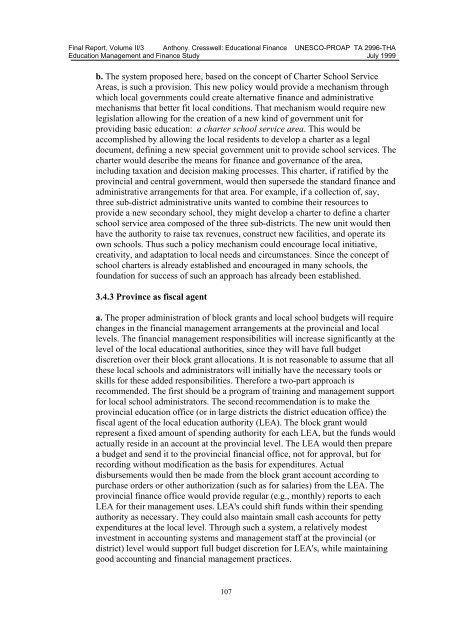Educational Finance in Thailand - UNESCO Bangkok
Educational Finance in Thailand - UNESCO Bangkok
Educational Finance in Thailand - UNESCO Bangkok
You also want an ePaper? Increase the reach of your titles
YUMPU automatically turns print PDFs into web optimized ePapers that Google loves.
F<strong>in</strong>al Report, Volume II/3 Anthony. Cresswell: <strong>Educational</strong> <strong>F<strong>in</strong>ance</strong> <strong>UNESCO</strong>-PROAP TA 2996-THA<br />
Education Management and <strong>F<strong>in</strong>ance</strong> Study July 1999<br />
b. The system proposed here, based on the concept of Charter School Service<br />
Areas, is such a provision. This new policy would provide a mechanism through<br />
which local governments could create alternative f<strong>in</strong>ance and adm<strong>in</strong>istrative<br />
mechanisms that better fit local conditions. That mechanism would require new<br />
legislation allow<strong>in</strong>g for the creation of a new k<strong>in</strong>d of government unit for<br />
provid<strong>in</strong>g basic education: a charter school service area. This would be<br />
accomplished by allow<strong>in</strong>g the local residents to develop a charter as a legal<br />
document, def<strong>in</strong><strong>in</strong>g a new special government unit to provide school services. The<br />
charter would describe the means for f<strong>in</strong>ance and governance of the area,<br />
<strong>in</strong>clud<strong>in</strong>g taxation and decision mak<strong>in</strong>g processes. This charter, if ratified by the<br />
prov<strong>in</strong>cial and central government, would then supersede the standard f<strong>in</strong>ance and<br />
adm<strong>in</strong>istrative arrangements for that area. For example, if a collection of, say,<br />
three sub-district adm<strong>in</strong>istrative units wanted to comb<strong>in</strong>e their resources to<br />
provide a new secondary school, they might develop a charter to def<strong>in</strong>e a charter<br />
school service area composed of the three sub-districts. The new unit would then<br />
have the authority to raise tax revenues, construct new facilities, and operate its<br />
own schools. Thus such a policy mechanism could encourage local <strong>in</strong>itiative,<br />
creativity, and adaptation to local needs and circumstances. S<strong>in</strong>ce the concept of<br />
school charters is already established and encouraged <strong>in</strong> many schools, the<br />
foundation for success of such an approach has already been established.<br />
3.4.3 Prov<strong>in</strong>ce as fiscal agent<br />
a. The proper adm<strong>in</strong>istration of block grants and local school budgets will require<br />
changes <strong>in</strong> the f<strong>in</strong>ancial management arrangements at the prov<strong>in</strong>cial and local<br />
levels. The f<strong>in</strong>ancial management responsibilities will <strong>in</strong>crease significantly at the<br />
level of the local educational authorities, s<strong>in</strong>ce they will have full budget<br />
discretion over their block grant allocations. It is not reasonable to assume that all<br />
these local schools and adm<strong>in</strong>istrators will <strong>in</strong>itially have the necessary tools or<br />
skills for these added responsibilities. Therefore a two-part approach is<br />
recommended. The first should be a program of tra<strong>in</strong><strong>in</strong>g and management support<br />
for local school adm<strong>in</strong>istrators. The second recommendation is to make the<br />
prov<strong>in</strong>cial education office (or <strong>in</strong> large districts the district education office) the<br />
fiscal agent of the local education authority (LEA). The block grant would<br />
represent a fixed amount of spend<strong>in</strong>g authority for each LEA, but the funds would<br />
actually reside <strong>in</strong> an account at the prov<strong>in</strong>cial level. The LEA would then prepare<br />
a budget and send it to the prov<strong>in</strong>cial f<strong>in</strong>ancial office, not for approval, but for<br />
record<strong>in</strong>g without modification as the basis for expenditures. Actual<br />
disbursements would then be made from the block grant account accord<strong>in</strong>g to<br />
purchase orders or other authorization (such as for salaries) from the LEA. The<br />
prov<strong>in</strong>cial f<strong>in</strong>ance office would provide regular (e.g., monthly) reports to each<br />
LEA for their management uses. LEA's could shift funds with<strong>in</strong> their spend<strong>in</strong>g<br />
authority as necessary. They could also ma<strong>in</strong>ta<strong>in</strong> small cash accounts for petty<br />
expenditures at the local level. Through such a system, a relatively modest<br />
<strong>in</strong>vestment <strong>in</strong> account<strong>in</strong>g systems and management staff at the prov<strong>in</strong>cial (or<br />
district) level would support full budget discretion for LEA's, while ma<strong>in</strong>ta<strong>in</strong><strong>in</strong>g<br />
good account<strong>in</strong>g and f<strong>in</strong>ancial management practices.<br />
107

















